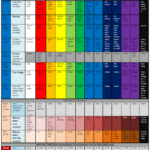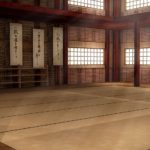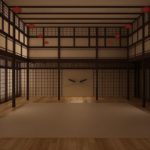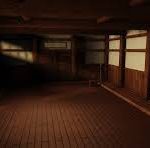This is where formal and legal sparring/fighting is done.
–
Table of Contents:
- Introduction
- The Military’s MAP Belt System
- Check Course Seat Availability
- Conceptual Images
–
Introduction:
The New Horizon’s dojo offers professional instruction in Mixed Martial Arts (MMA), Ninjutsu, Krav Maga, Sayoc Kali (available to active duty personnel and law enforcement only), Tai Chi, Jeet Kune Do, Yoga (including partners yoga), and more. Classes are free, but seats are limited. R.S.V.P. and confirm your reservation, and make any necessary cancellations via The New Horizon‘s intranet to courteously and promptly keep your fellow crew-mates alerted to openings.
–
The Military’s MAP Belt System:
Inspired by the Marine Corps’ Martial Arts Program (MCMAP) on Earth-that-was, TNH’s MAP program/system is designed based on the same principles; it is a fighting style developed to allow people wearing uniforms and armor to successfully and efficiently defeat human-sized opponents on-foot, whether they are armed or not.
Personnel stationed aboard The New Horizon may use this dojo to earn their Tan, Gray, Green, Brown, and Black belts in this fighting style, including with their (the later belts in that series’) various colored tab devices. (A colored cloth tab is added to a Black belt, for example, to indicate a progression or specialization within that martial-arts skill-level / tier / mastery).
Tan Belt
The tan belt syllabus focuses on the development of the basics of armed and unarmed combat. Students start with the Basic Warrior Stance and break-falls are taught for safety, then move to:
- Basic punches, uppercuts, and hooks
- Basic upper-body strikes, including the eye gouge, hammer fists, and elbow strikes
- Basic lower-body strikes, including kicks, knee strikes, and stomps
- Bayonet techniques
- Basic chokes, joint locks, and throws
- Counters to strikes, chokes, and holds
- Basic unarmed restraints and armed manipulations
- Basic knife techniques
- Basic weapons of opportunity
In order to obtain a tan belt the student must score 80 %, students can fail no more than 10 techniques. If a student fails testing, he/she must wait a minimum of 24 hours before retesting. The tan belt syllabus is part of The Basic School and recruit training curriculum.
Gray Belt
The gray belt syllabus expands on the basic techniques with:
- Intermediate bayonet techniques
- Intermediate upper-body strikes including knife-hands (karate chops) and elbow strikes
- Intermediate lower-body strikes including kicks, knee strikes, and stomps
- Intermediate chokes, joint locks, and throws
- Counters to strikes, chokes, and holds
- Intermediate unarmed restraints and arm/wrist manipulations
- Intermediate knife techniques
- Basic ground fighting
- Intermediate weapons of opportunity
In addition to the new techniques learned, the student must show knowledge of the previous belt by executing 5 techniques from tan belt. If a student performs any of the 5 techniques incorrectly, the student fails the testing evaluation. In order to obtain a gray belt the student must score 80%, students can fail no more than 10 techniques. If a student fails testing, he/she must wait a minimum of 24 hours before retesting.
Green Belt
- Intermediate Knife Techniques
- Intermediate Weapon of Opportunity Techniques (Blocking)
- Intermediate Ground Fighting w/ Arm Bars
- Intermediate Bayonet Training
- Intermediate Chokes (from the side)
- Intermediate Throws (Shoulder)
- Lower Body Strikes
- Counters to Strikes
- Unarmed Joint Manipulations w/ Enhanced Pain Compliance
Brown Belt
- advanced bayonet techniques
- advanced ground fighting and chokes
- advanced throws
- unarmed vs. hand held weapons
- firearm retention
- firearm disarmament
- advanced knife techniques
Black Belt 1st Degree
- advanced bayonet techniques
- advanced chokes, holds, and throws
- advanced ground fighting
- basic counter firearm techniques
- advanced upper-body strikes, including strikes and smashes
- advanced knife techniques
- pressure points
- improvised weapons
- counterattacks
Black Belt 2nd Degree
- rifle vs. rifle
- short weapon vs. rifle
- unarmed vs. rifle
–
Check Course Seat Availability:
You can check the weekly schedule of classes, as well as how many seats in each class are still available, from your work station, tough-net-book, and vambrace LCD-scroll.
–
–
















